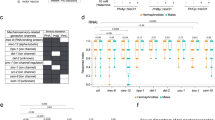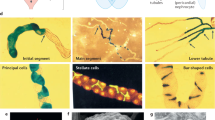Abstract
The stereotyped mating behaviour of the Caenorhabditis elegans male is made up of several substeps: response, backing, turning, vulva location, spicule insertion and sperm transfer. The complexity of this behaviour is reflected in the sexually dimorphic anatomy and nervous system1. Behavioural functions have been assigned to most of the male-specific sensory neurons by means of cell ablations; for example, the hook sensory neurons HOA and HOB are specifically required for vulva location2. We have investigated how sensory perception of the hermaphrodite by the C. elegans male controls mating behaviours. Here we identify a gene, lov-1 (for location of vulva), that is required for two male sensory behaviours: response and vulva location. lov-1 encodes a putative membrane protein with a mucin-like, serine–threonine-rich amino terminus3 followed by two blocks of homology to human polycystins, products of the autosomal dominant polycystic kidney-disease loci PKD1 and PKD2 (ref 4). LOV-1 is the closest C. elegans homologue of PKD1. lov-1 is expressed in adult males in sensory neurons of the rays, hook and head, which mediate response, vulva location, and potentially chemotaxis to hermaphrodites, respectively2,5. PKD-2, the C. elegans homologue of PKD2, is localized to the same neurons as LOV-1, suggesting that they function in the same pathway.
This is a preview of subscription content, access via your institution
Access options
Subscribe to this journal
Receive 51 print issues and online access
$199.00 per year
only $3.90 per issue
Buy this article
- Purchase on Springer Link
- Instant access to full article PDF
Prices may be subject to local taxes which are calculated during checkout



Similar content being viewed by others
References
Hodgkin,J. in The Nematode C. elegans (ed. Wood, B.) 243–279 (Cold Spring Harbor Laboratory Press, New York, 1988).
Liu,K. S. & Sternberg,P. W. Sensory regulation of male mating behavior in Caenorhabditis elegans. Neuron 14, 79–89 (1995).
Carraway,K. L. & Fregien,N. Mucin structure and function: Insights from molecular biology. Trends Glycosci. Glycotechnol. 7, 31–44 (1995).
Torres,V. D. New insights into polycystic kidney disease and its treatment. Curr. Opin. Nephrol. Hypertens. 7, 159–169 (1998).
Ward,S., Thomson,N., White,J. G. & Brenner,S. Electron microscopical reconstruction of the anterior sensory anatomy of the nematode Caenorhabditis elegans. J. Comp. Neurol. 160, 313–337 (1975).
White,J. G., Southgate,D., Thomson,J. N. & Brenner,S. The structure of the nervous system of Caenorhabditis elegans. Phil. Trans. R. Soc. Lond. B 314, 1–340 (1986).
Collet,J., Spike,C. A., Lundquist,E. A., Shaw,J. E. & Herman,R. K. Analysis of osm-6, a gene that affects sensory cilium structure and sensory neuron function in Caenorhabditis elegans. Genetics 148, 187–200 (1998).
Kaplan,J. M. & Horvitz,H. R. A dual mechanosensory and chemosensory neuron in Caenorhabditis elegans. Proc. Natl Acad. Sci. USA 90, 2227–2231 (1993).
Perkins,L. A., Hedgecock,E. M., Thomson,J. N. & Culotti,J. G. Mutant sensory cilia in the nematode Caenorhabditis elegans. Dev. Biol. 117, 456–487 (1986).
Mochizuki,T. et al. PKD2, a gene for polycystic kidney disease that encodes an integral membrane protein. Science 242, 1339–1342 (1996).
Montell,C. & Rubin,G. M. Molecular characterization of the Drosophila trp locus: a putative integral membrane protein required for phototransduction. Neuron 2, 1313–1323 (1989).
Sanford,R. et al. Comparative analysis of the polycystic kidney disease 1 (PKD1) gene reveals an integral membrane glycoprotein with multiple evolutionary conserved domains. Hum. Mol. Genet. 9, 1483–1489 (1997).
Nomura,H. et al. Identification of PKDL, a novel polycystic kidney disease 2-like gene whose murine homologue is deleted in mice with kidney and retinal defects. J. Biol. Chem. 273, 25967–25973 (1998).
Wu,G. et al. Identification of PKD2L, a human PKD2-related gene: Tissue-specific expression and mapping to chromosome 10q25. Genomics 54, 564–568 (1998).
Qian,F. et al. PKD1 interacts with PKD2 through a probably coiled-coil domain. Nature Genet. 16, 179–183 (1997).
Tsiokas,L., Kim,E., Arnould,T., Sukhatme,V. P. & Walz,G. Homo- and heterodimeric interactions between the gene products of PKD1 and PKD2. Proc. Natl Acad. Sci. USA 94, 6965–6970 (1997).
Arnould,T. et al. The polycystic kidney disease 1 gene product mediates protein kinase C α-dependent and c-Jun N-terminal kinase-dependent activation of the transcription factor AP-1. J. Biol. Chem. 273, 6013-6018 (1998).
Parnell,S. C. et al. The polycystic kidney disease-1 protein, polycystin-1, binds and activates heterotrimeric G-proteins in vitro. Biochem. Biophys. Res. Commun. 251, 625–631 (1998).
Kim,E. et al. The polycystic kidney kidney disease 1 gene product modulates Wnt signaling. J. Biol. Chem. 274, 4947–4953 (1999).
Tsiokas,L. et al. Specific association of the gene product of PKD2 with the TRPC1 channel. Proc. Natl Acad. Sci. USA 7, 3934–3939 (1999).
Sullivan,L. P., Wallace,D. P. & Grantham,J. J. Epithelial transport in polycystic kidney disease. Physiol. Rev. 78, 1165–1191 (1998).
Hudspeth,A. J. How the ear's works work. Nature 341, 397–404 (1989).
Driscoll,M. & Kaplan,J. in C. elegans II (ed. Riddle, D. I., Blumenthal, T., Meyer, B. J. & Priess, J. R.) 645–677 (Cold spring Harbor Laboratory Press, New York, 1997).
Montell,C. TRP trapped in the fly signalling web. Curr. Opin. Neurobiol. 8, 389–397 (1998).
Brenner,S. The genetics of Caenorhabditis elegans. Genetics 77, 71–94 (1974).
Hodgkin,J. Male phenotypes and mating efficiency in Caenorhabditis elegans. Genetics 103, 43–64 (1983).
Hodgkin,J. & Doniach,T. Natural variation and copulatory plug formation in Caenorhabditis elegans. Genetics 146, 149–164 (1997).
Schnabel,H. & Schnabel,R. An organ-specific differentiation gene, pha-1, from Caenorhabditis elegans. Science 250, 686–688 (1990).
Chalfie,M., Tu,Y., Euskirchen,G., Ward,W. W. & Prasher,D. D. Green fluorescent protein as a marker for gene expression. Science 263, 802–805 (1994).
Sulston,J. D., Albertson,D. G. & Thomson,J. N. The Caenorhabditis elegans male: Postembryonic development of nongonadal structures. Dev. Biol. 78, 542–576 (1980).
Acknowledgements
We thank J. Copeland for help isolating lov-1(sy582Δ); L. Jiang, R. Garcia and R. Ballester for discussions and constructive criticisms; members of our lab, S. Myers and M. Snow for experimental suggestions; D. Sherwood and B. Smith for assistance with confocal microscopy; A. Fire for vectors; and R. Herman for osm-6::gfp. The Caenorhabditis Genetics stock Center and Sanger Center provided numerous strains, cosmids and sequencing data. This work was supported by the Howard Hughes Medical Institute, with which P.W.S. is an investigator and M.M.B. is an associate, and by the Seaver Institute.
Author information
Authors and Affiliations
Corresponding author
Rights and permissions
About this article
Cite this article
Barr, M., Sternberg, P. A polycystic kidney-disease gene homologue required for male mating behaviour in C. elegans. Nature 401, 386–389 (1999). https://doi.org/10.1038/43913
Received:
Accepted:
Issue Date:
DOI: https://doi.org/10.1038/43913
This article is cited by
-
Transport and barrier mechanisms that regulate ciliary compartmentalization and ciliopathies
Nature Reviews Nephrology (2024)
-
Primary cilia as dynamic and diverse signalling hubs in development and disease
Nature Reviews Genetics (2023)
-
Sexual morph specialisation in a trioecious nematode balances opposing selective forces
Scientific Reports (2022)
-
Modelling ciliopathy phenotypes in human tissues derived from pluripotent stem cells with genetically ablated cilia
Nature Biomedical Engineering (2022)
-
Control of the Hedgehog pathway by compartmentalized PKA in the primary cilium
Science China Life Sciences (2022)
Comments
By submitting a comment you agree to abide by our Terms and Community Guidelines. If you find something abusive or that does not comply with our terms or guidelines please flag it as inappropriate.



